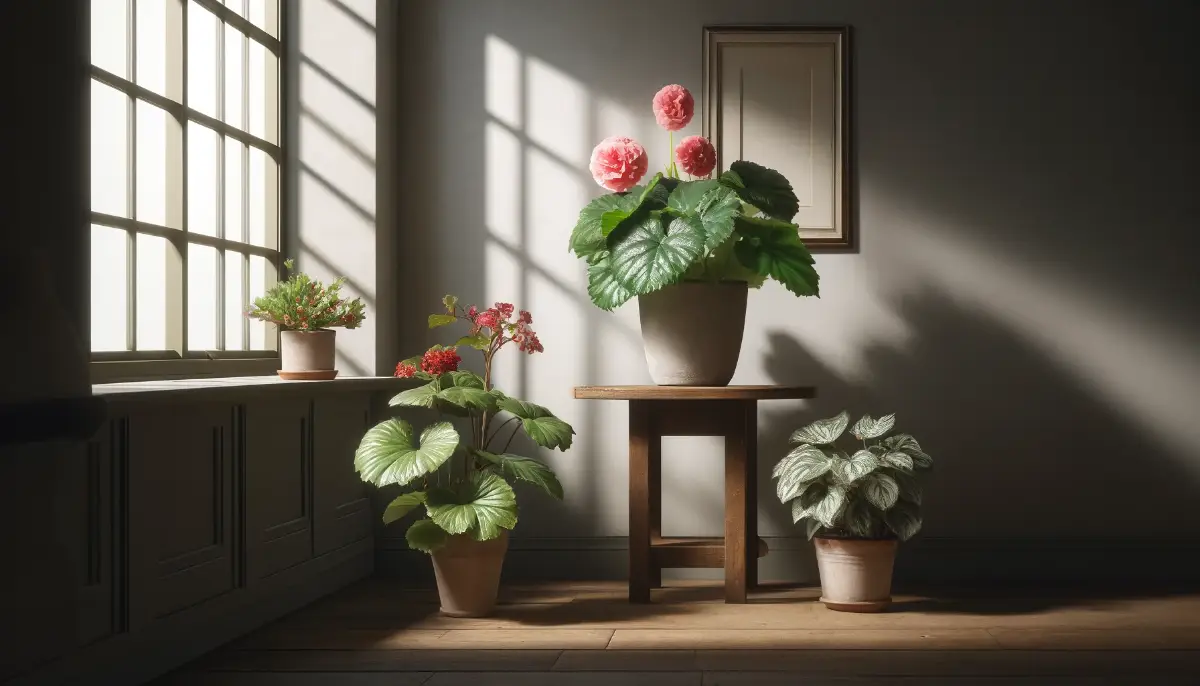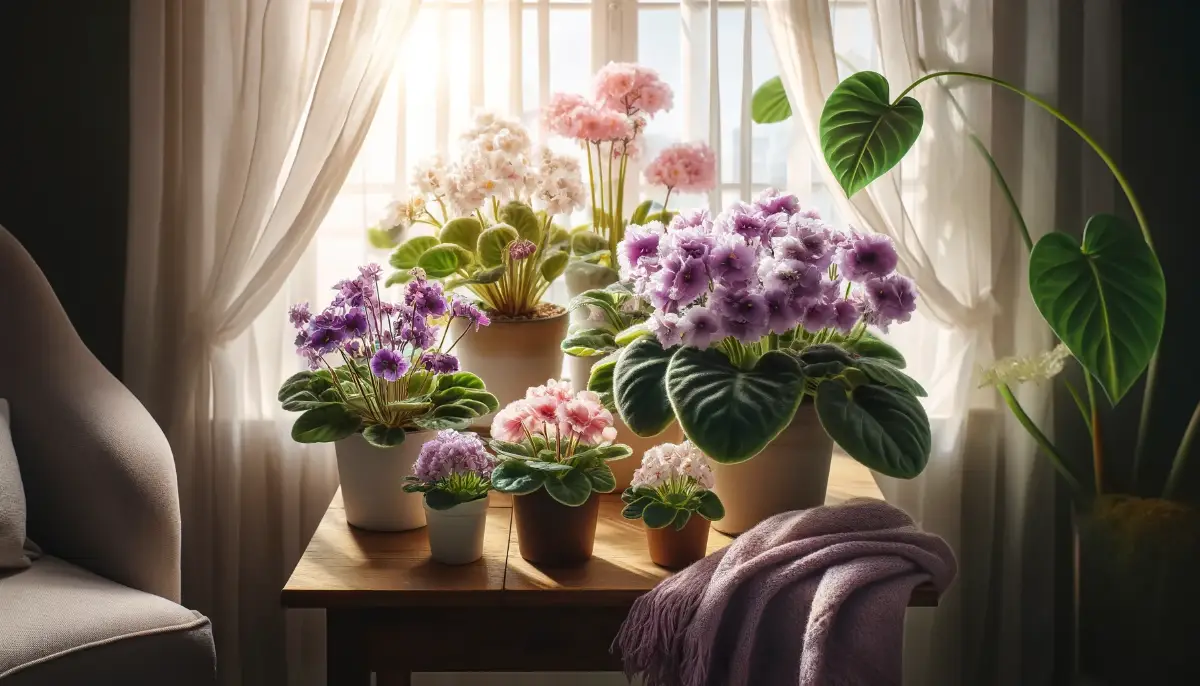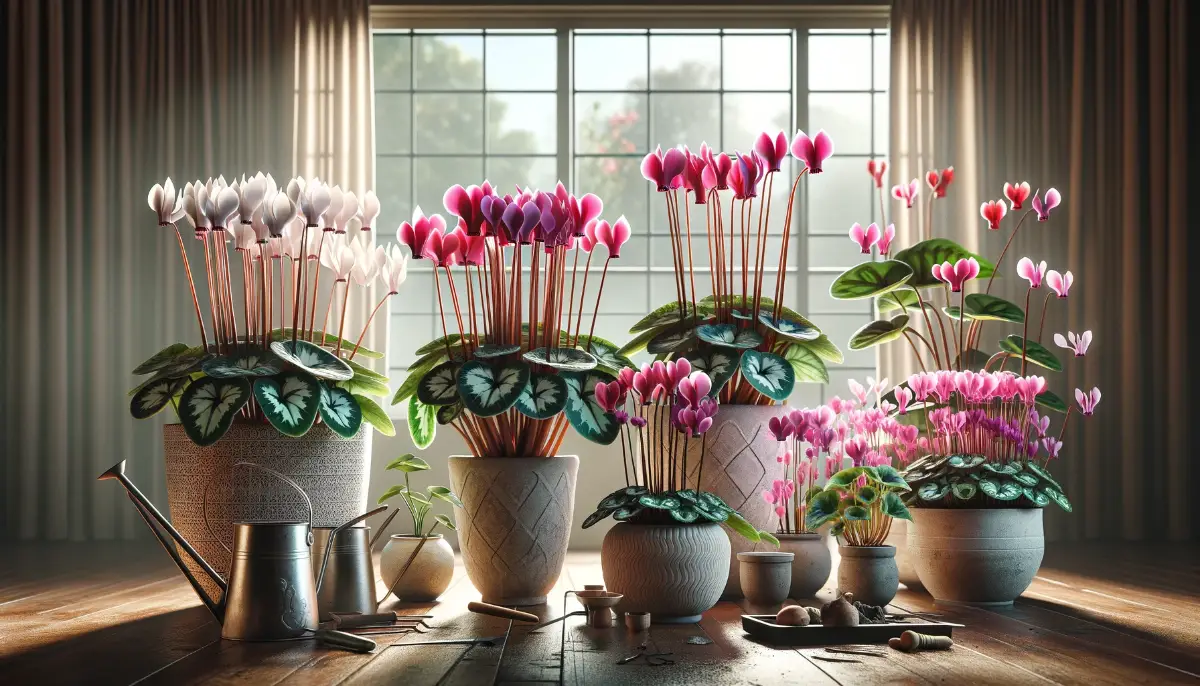Begonias, with their captivating blooms and lush foliage, are a stunning addition to any indoor garden. Thriving under the right conditions, they fill homes with vibrant colors and a touch of nature’s serenity.
Perfect for both novice and experienced gardeners, begonias can transform a mundane space into a vibrant, living area with just a bit of knowledge and care.
Most popular varieties
- Tuberous Begonias (Begonia tuberhybrida): Known for their spectacular flowers, tuberous begonias come in many shapes, including ruffled or rose-like forms. They thrive in cool, moist environments and are ideal for summer gardens.
- Wax Begonias (Begonia semperflorens): These are hardy plants with waxy leaves and clusters of small flowers. They are excellent for ground covers and flower beds as they bloom continuously throughout the summer and fall.
- Rex Begonias (Begonia rex): Celebrated for their vividly colored and patterned leaves, Rex begonias are primarily grown for their foliage rather than their flowers. They are perfect for indoor plant collections or shady garden spots.
- Cane Begonias: Also known as “angel wing” begonias, they have long stems with “wing”-shaped leaves and clusters of hanging flowers. They’re great for baskets and pots.
- Rhizomatous Begonias: These have thick rhizomes and are known for their interesting leaf shapes and textures. They grow well indoors and can have a sprawling habit.
Each variety has its own specific care requirements, but generally, begonias prefer a warm, humid environment and indirect sunlight. They can be sensitive to overwatering and require well-draining soil
Basic Begonia Care
Light Requirements
Begonias thrive best when provided with bright, indirect light. Placing them near an east or west-facing window where they can receive gentle morning or evening sunlight is ideal.
Direct sunlight, especially during the peak hours of the day, should be avoided as it can scorch their delicate leaves. For those growing begonias in less naturally lit areas, supplementing with grow lights may be necessary to prevent the plants from becoming leggy as they stretch towards the light source.
Temperature and Humidity
Begonias perform best in temperatures that are commonly found in household environments, typically ranging between 65-80°F (18-27°C). It’s crucial to protect them from drastic temperature changes and avoid placing them in areas where cold drafts or extreme heat might occur, such as near air conditioning units or radiators.
Humidity is also an important factor for begonias. They prefer a humid environment to thrive, which can be a challenge in dry indoor climates. To increase humidity around your begonias, you can use a pebble tray filled with water placed beneath the plants, or employ a humidifier nearby. Misting is generally not recommended for begonias, as it can lead to leaf problems such as powdery mildew or fungal infections.
Ensuring the right temperature and humidity levels will help your begonias stay healthy and vibrant, promoting lush foliage and beautiful blooms.
Soil Composition
For optimal growth, begonias require a soil composition that is well-draining yet capable of retaining enough moisture to keep the roots evenly moist without becoming soggy. A suitable begonia potting mix often includes the following components:
- Peat Moss: Helps in moisture retention and provides a light, airy structure to the soil.
- Perlite: Increases aeration, helping to keep the soil loose and well-draining which prevents root rot.
- Vermiculite: Also helps in moisture retention and adds minerals to the soil which can be beneficial for plant growth.
- Organic Compost: Enriches the soil with nutrients, promoting healthier plant growth and flowering.
Helpful Articles:
Peat Moss: How Should It Be Used with Indoor Plants
Vermiculite or Perlite: How to Using in Your Indoor Organic Garden
Making Your Own Organic Soil: A Sustainable Approach to Indoor Gardening
This mix ensures that the soil remains light and fluffy, allowing air to reach the roots, which is crucial for the health of the plant. It’s also important to ensure that the potting mix is slightly acidic to neutral in pH, as begonias prefer a pH range of about 5.5 to 6.5.
When preparing or purchasing soil for begonias, it’s vital to ensure that it doesn’t compact over time, which can hinder water drainage and air flow, potentially harming the plant. Regularly checking and adjusting the soil composition is key to maintaining a healthy begonia.
Repotting Tips
Repotting begonias is a crucial aspect of their care that helps to maintain a healthy root system and promote vigorous growth. Here are some tips for repotting your begonias effectively:
- Timing: The best time to repot begonias is in the spring, just before the growing season begins. This allows the plant to quickly adapt to the new pot and utilize the fresh soil as it enters its active growth phase.
- Choosing the Right Pot: Select a pot that is only one size larger than the current one. Begonias prefer to be slightly root-bound, and too much extra space can lead to excess moisture in the soil, which might cause root rot. Ensure the new pot has good drainage holes.
- Soil Selection: Use a light, well-draining potting mix designed for indoor plants. A mixture containing peat moss, perlite, and vermiculite is ideal, as it provides the right balance of drainage and moisture retention.
- Removing the Plant: Gently remove the begonia from its current container, taking care to disturb the roots as little as possible. Shake off the old soil, and trim any dead or overly long roots.
- Repotting: Place a layer of new potting soil in the bottom of the pot, then position the begonia so the top of the rootball is about an inch below the rim of the pot. Fill in around the roots with more potting mix, gently tamping it down to eliminate air pockets.
- Aftercare: Water the plant thoroughly after repotting, then place it in a location where it receives appropriate light and temperature. Avoid fertilizing immediately after repotting to give the roots time to heal and acclimate to their new environment.
Watering Technique
Watering begonias properly is key to their health, as they are sensitive to both overwatering and underwatering. Here are some tips to ensure your begonia gets just the right amount of water:
Check the Soil: Before watering, check the top inch of the soil; if it feels dry to the touch, it’s time to water. This prevents overwatering, which can lead to root rot.
Water Thoroughly: When you water, do so thoroughly until water runs out of the drainage holes at the bottom of the pot. This ensures that the entire root ball is moistened.
Let It Drain: Always allow the excess water to drain away. Begonias should not sit in water as this can cause the roots to rot. Ensure that the pot has good drainage to facilitate this process.
Frequency: The frequency of watering will depend on various factors such as the size of the plant, the pot, the temperature, humidity levels, and the growth phase of the plant. In general, begonias like to be watered more frequently during their active growing season in spring and summer, and less so in the cooler months.
Avoid Wetting Leaves: When watering, try to keep water off the begonia’s leaves to prevent issues like powdery mildew or fungal infections. Water directly onto the soil instead.
Organic Fertilization Tips
Fertilizing begonias with organic nutrients is an excellent way to support their growth while maintaining an eco-friendly garden. Here are some organic fertilizing tips for begonias:
Choose the Right Fertilizer: Opt for an organic, balanced fertilizer that’s suitable for flowering plants. Products typically labeled as having an equal ratio of nitrogen, phosphorus, and potassium (such as 10-10-10) are good choices. Organic options can include fish emulsion, seaweed extract, or compost tea.
Application Frequency: During the growing season (spring and summer), fertilize begonias once a month. It’s best to dilute the fertilizer to half the strength recommended on the package to avoid over-fertilizing, which can harm the plants.
Apply Carefully: Apply the fertilizer to the soil around the plants, avoiding direct contact with the leaves and stems, which can be sensitive to chemical burns, even from organic products.
Stop Fertilizing in Dormancy: Reduce or stop fertilizing in the fall and winter when begonias typically enter a dormant period. Continuing to fertilize during these months can lead to poor plant health due to the accumulation of unused nutrients.
Complement with Compost: Enhance the soil’s nutrient content by mixing in well-rotted compost at the time of planting or during repotting. Compost not only provides a slow release of nutrients but also improves soil structure and moisture retention.
Pruning and Maintenance
Pruning and maintaining your begonias are essential practices to keep them healthy and encourage vibrant blooms. Here’s how you can effectively prune and maintain your begonias:
- Pruning for Health: Regularly remove dead or dying leaves and flowers to prevent disease and encourage new growth. This helps the plant focus its energy on producing healthy foliage and flowers.
- Pruning for Shape: Begonias can become leggy or overgrown. To maintain a compact and attractive shape, pinch or cut back the stems. This will promote bushier growth. Pruning should be done with clean, sharp scissors or pruners to avoid damaging the plant.
- Timing: The best time for heavy pruning is in the spring as begonias begin their active growth phase. However, light pruning and deadheading (removing spent flowers) can be done throughout the growing season to keep plants looking tidy.
- Cleaning Up: After pruning, clean up any fallen debris around the plant. This helps prevent the onset of disease and keeps pests from being attracted to the area.
- Assessing Plant Needs: Watch for signs of stress in your begonia, such as yellowing leaves or stunted growth, which can indicate a need for pruning or other care adjustments.
By following these tips, you’ll help your begonias stay lush and productive, enhancing their appearance and longevity. Regular pruning and maintenance not only improve the health of the begonias but also increase the aesthetic appeal of your garden or indoor plant display.
Propagation Techniques
Propagating begonias is a rewarding way to expand your collection or share plants with friends and family. There are several effective methods you can use, depending on the type of begonia:
Stem Cuttings: This is one of the easiest and most common methods for propagating begonias, especially fibrous and cane types.
- Procedure: Cut a healthy stem about 4 inches long, just below a node (where a leaf joins the stem).
- Rooting: Remove the lower leaves and dip the cut end in rooting hormone to encourage root growth. Plant the cutting in a moist, well-draining potting mix. Cover with a plastic bag or place in a propagator to maintain high humidity until roots develop.
Leaf Cuttings: This method is particularly effective for Rex begonias.
- Procedure: Cut a healthy leaf, leaving about an inch of stem. You can also slice large leaves into sections, ensuring each piece includes part of a vein.
- Rooting: Dip the cut end or bottom part of the leaf into rooting hormone and then place it in a moist potting mix. As with stem cuttings, cover to maintain humidity.
Division: Suitable for rhizomatous begonias that grow from a central rhizome.
- Procedure: Gently lift the plant and use your hands or a clean knife to divide the rhizome into sections, ensuring each section has at least one growing point.
- Planting: Replant each section in its own pot with suitable potting mix.
Tuber Division: Effective for tuberous begonias after the plant has gone dormant.
- Procedure: Once the foliage has died back, carefully dig up the tubers. Cut the tuber into pieces, each with a bud.
- Planting: Let the cut surfaces dry to form a callus for a day or two before planting in moist, well-draining soil.
Each method has its nuances, and success can depend on factors like the specific begonia variety, environmental conditions, and timing. For best results, ensure your propagation materials are clean to prevent the spread of disease, and maintain moderate temperature and indirect light until the new plants are established
Troubleshooting Common Issues
Troubleshooting common issues with begonias involves recognizing the symptoms and understanding the probable causes. Here are some typical problems that begonia owners might face, along with solutions to address them:
Yellowing Leaves:
- Cause: Overwatering is a common reason for yellowing leaves in begonias. Less frequently, it can also be due to under-watering or nutrient deficiencies.
- Solution: Check the moisture level of the soil before watering. The soil should be slightly dry between waterings. If the plant is overwatered, allow the soil to dry out and adjust your watering schedule.
Brown Leaf Edges:
- Cause: This can be caused by low humidity, over-fertilization, or salt buildup in the soil.
- Solution: Increase humidity around the plant using a pebble tray or a humidifier. Flush the soil occasionally to remove excess salts by watering thoroughly until water runs freely from the drainage holes.
Powdery Mildew:
- Cause: A fungal disease that appears as white, powdery spots on leaves. It often occurs when leaves are damp for extended periods or in low light conditions.
- Solution: Improve air circulation around your begonia and reduce leaf wetness. Treat with an organic fungicide like neem oil or a baking soda solution.
Dropping Leaves:
- Cause: Caused by shock from sudden changes in environment, such as temperature drops, or from overwatering.
- Solution: Ensure the plant is not in a drafty area and try to keep the environmental conditions around your begonia as stable as possible. Adjust watering practices to ensure the soil is not too soggy.
Pest Problems (Mealybugs, Aphids, Spider Mites):
- Cause: Pests are attracted to stressed plants and those kept in poor conditions.
- Solution: Remove pests manually with a cotton swab dipped in rubbing alcohol, or use an organic insecticidal soap. Maintaining plant health and cleanliness helps prevent infestations.
By identifying the symptoms early and applying the appropriate solutions, you can effectively manage and resolve common issues with begonias, ensuring that your plants remain healthy and vibrant. Regular monitoring and maintenance are key to successful begonia care.
FAQs About Begonia Care
What is the best light for begonias?
Begonias prefer bright, indirect light. Direct sunlight can scorch their leaves, so a spot near a window with filtered light is ideal.
How often should I water my begonia?
Water your begonia when the top inch of soil feels dry. Overwatering can lead to root rot, so ensure the soil is not constantly wet.
Do begonias need special soil?
Yes, begonias thrive in well-draining, fertile soil with a slightly acidic to neutral pH. A mix of peat moss, perlite, and vermiculite is often recommended.
When is the best time to repot begonias?
Spring is the best time to repot begonias, just before their growth period begins. This helps them adjust to new pots and soil before their active growing season.
How do I prune a begonia?
Regularly prune dead or dying leaves and flowers to promote new growth and maintain the plant’s shape. Use clean, sharp scissors for pruning.
Can begonias be grown outdoors?
Begonias can be grown outdoors in climates without frost. They perform best in shaded areas where they are protected from direct sunlight.
Are begonias toxic to pets?
Yes, some begonia species are toxic if ingested by pets. It’s best to keep them out of reach of animals and children.
How do I propagate begonias?
Begonias can be propagated through stem cuttings, leaf cuttings, or division. The method depends on the type of begonia.
What common pests affect begonias?
Begonias may be affected by pests like aphids, mealybugs, and spider mites. Regular inspection and cleaning can help prevent infestations.
How can I treat fungal diseases in begonias organically?
To treat fungal diseases organically, improve air circulation around your plants, avoid getting leaves wet, and use a baking soda and water mixture as a fungicide.









